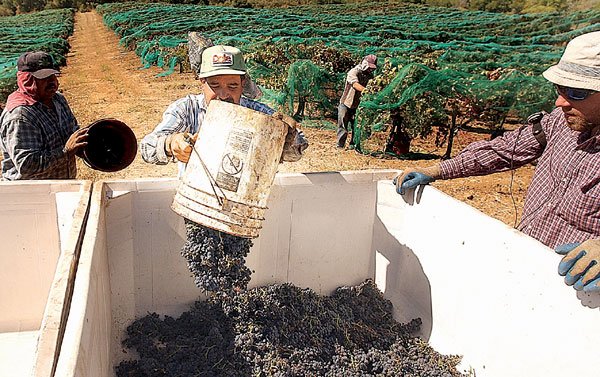By Melania Zaharopoulos
Over a storm ditch, down a winding gravel drive, and past a
tiny, scripted granite sign, the late morning sun warms the eight
acres of grapes known as Sarah’s Vineyard in Gilroy.
A metal shed surrounded by vines serves as both tasting room and
storage facility, housing some of the 3,000 cases of vino the
fledgling winery produces each year.
By Melania Zaharopoulos
Over a storm ditch, down a winding gravel drive, and past a tiny, scripted granite sign, the late morning sun warms the eight acres of grapes known as Sarah’s Vineyard in Gilroy.
A metal shed surrounded by vines serves as both tasting room and storage facility, housing some of the 3,000 cases of vino the fledgling winery produces each year. Two men are busy picking grapes near the entrance, harvesting wine grapes whose final sales are still more than a year away.
The wine harvest is on, and despite a second-year slump in harvest quantities, Dave Heiber, the winemaker at Sarah’s, is optimistic about the prospects of this year’s crop.
“I want a full and ripe wine without a vegetal flavor,” said Heiber. “I prefer a fruit-based flavor, and here it’s hot enough to ripen the fruit, but cool enough to let it sit on the vine and mature.”
The equation hasn’t worked out perfectly, though. An early spring coupled with warmer temperatures in Santa Clara and San Benito counties may jeopardize the quality of this year’s vintage, said Corneliu Dane, assistant winemaker at Calera Wineries in Hollister.
Nestled in the hills outside Hollister, Calera’s offices and tasting room exude a Napa Valley-style chic. Rambling floral vines shade their small parking lot, and the processing facility combines the rustic and modern, seamlessly blending split-beam ceilings with the clean lines of glass, wire and aluminum.
Just past the main entry way is a state-of-the-art fermentery where Dane monitors the sugar and acid concentrations in the grapes. Most small wineries decide to pick their grapes based on taste-testing and the use of a refractometer, a hand-held device that measures a grape’s sugar concentration based on how its juice bends, or refracts, sunlight. But for a larger winery like Calera, this isn’t enough. Dane uses more sophisticated laboratory equipment to determine not only the sugar content, but the acid concentration as well.
Ideally, says Dane, a Chardonnay grape should have a sugar content of 24 percent and an acid concentration of less than 0.8 grams per liter. Sound confusing enough?
Aside from being a sweaty nuisance, warmer weather causes grapes to ripen faster, driving up their sugar content as they are left on the vine. But picked too soon, the grapes will contain too much acid to make a smoothly palatable table wine. In order to get his acid levels low enough, Dane has been forced to watch his sugar levels rise to 25 and 26 percent, disturbing the balance of acidic and sweet tastes that keep customers’ tastebuds entertained.
“I think the problem we’re having, and that all the vineyards around are having, is that all the grapes are becoming ripe pretty close together, even among the other varieties,” says Dane. “The challenge will be to get enough people to come and pick so that we get the grapes in on time before they ripen too much.” The window of opportunity may be just a few days, says Heiber.
But it will take Calera’s 20-man crew nearly two weeks to pick the 100 to 125 tons of grapes that the winery’s Mt. Harlan facility will produce this year. He will also produce wines from the 120 tons of grapes that the winery purchases for production.
Both Heiber and Dane prefer to pick early, as soon as first light breaks across the sky.
Pressing the Chardonnay grapes immediately while they are still cold, says Dane, keeps the juice’s contact with the grape skins to a minimum, reducing oxidation and keeping the wine from developing a bitter taste. The resulting juice is then allowed to ferment.
Heiber takes a different view. As long as the grapes make it into his storage facility cold, they can sit for a couple of days before pressing. This frees up his staff to continue picking.
When they do press the grapes, the extracted juice then settles in a refrigerated tank for 24 hours before barreling.
Producing red wines requires the whole fruit to ferment before the pressing stage. Heiber dumps whole clusters of his Pinot Noir grapes into plastic tubs. As the grapes ferment, their skins and stems float to the surface, creating a heavy plug. The plug is punched down by hand several times during the next 10-14 days, dying the wine its deep red color.
Pinot Noir, while popular in the area, is an especially tricky grape to work with. It is a genetically unstable plant whose thin skin and poor leaf cover leave it vulnerable to damage from birds and the sun.
Even if grapes make their way to the pressing stage intact, the wine has still been known to inexplicably lose its flavor in the bottling process and is also very susceptible to acetic acid bacteria, which vinegars poorly stored wines.
The only region in the world to produce high quality wines consistently from Pino Noir grapes is the Cote d’Or in France. Production in California has grown in recent years, however, and in-state labels have developed their own prominence. Since Heiber came on staff, Sarah’s Vineyard’s plantings of the famously fickle black grape have doubled.
To see how this year’s crop turns out, expect to wait at least two years. The fermenting process for Pinot Noir takes 16 to 20 months, and some wineries will often hold a wine in reserve for six months to a year. You may be able to sample Chardonnay earlier, though. It will be ready in 9 to 11 months.
If you would like to go on your own wine-tasting odyssey, stop by the numerous wineries from Morgan Hill to Hollister to conduct some “comparison research.”














